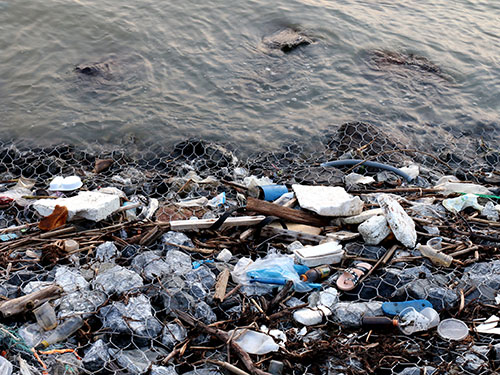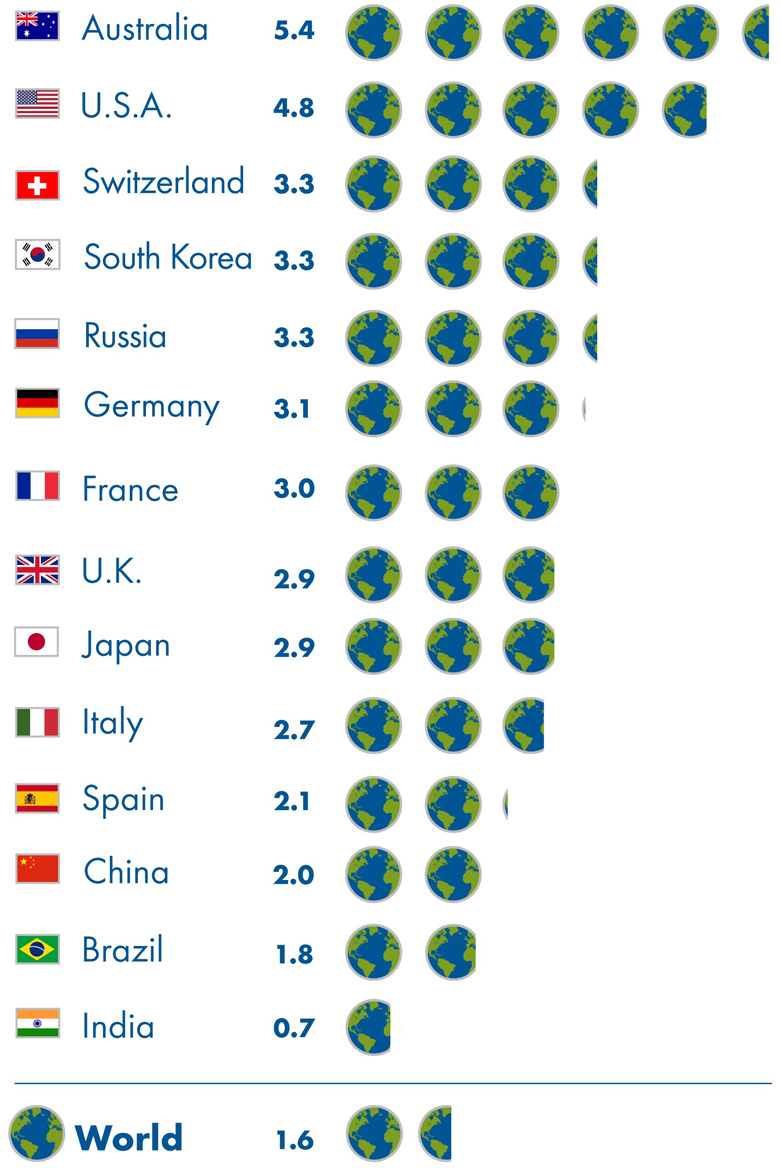Economies, populations, consumption and resource demands are growing, but the size of our planet remains the same. The consequence: since 1970, we have been using up more renewable natural resources than our planet can regenerate. The Ecological Footprint is a reliable data-driven metric and accounting tool that measures natural resource supply and demand expressed as a global hectare (gha). On the supply side, the Ecological Footprint (EF) shows how much nature, or biocapacity, we have. On the demand side, it shows how much we consume and who uses what.
The Ecological Footprint was conceived in 1990 by Dr Mathis Wackernagel and William Rees, a professor at the University of British Columbia. It is now widely used to monitor ecological resource consumption and advance sustainable development. Commissioned by the UNEP as early as 2001, a joint scientific publication was co-authored by Dr Wackernagel, Dr Karl-Henrik Robert, founder of The Natural Step, and other academics and thought leaders to show how the various tools could enhance each other if used within the systemic context of sustainability.
At The Natural Step, we consider the Footprint as a reliable indicator for monitoring aspects of environmental degradation. It measures the amount of biologically productive land and sea area required to produce all the resources our global population consumes and how much is required to absorb its waste. The Footprint takes each year’s technological advances and variety in productivity into account.



Among other calculations, it is applied to determine the date of Earth Overshoot Day for each year. Ecological overshoot occurs when human demand exceeds the regenerative capacity of a natural ecosystem. The measurements and calculations can be presented on a global, national, business or individual level. Combining the Ecological Footprint with human development shows that when countries develop they tend to increase their footprint if they do not develop intelligently.
Ecological footprint background
The Ecological Footprint tells us how close we are to the goal of sustainable living. Biocapacity serves as a lens showing the capacity of the biosphere to regenerate and provide for life. It allows researchers to add up the competing human demands, which include natural resources, waste absorption, water renewal and productive areas dedicated to urban and agricultural uses.
The Footprint uses robust definitions to provide reliable results, often expressed in global hectares. A hectare (ha) is one hundredth of a square kilometre, 10,000 square metres, approximately the size of 1.5 football pitches. A global hectare (gha) is the accounting unit for world average biological productivity for a specific year. It allows researchers to compare supply and demand for different types of land and for different years.
The Global Footprint Network closely collaborates with renowned partner organisations and initiatives around the globe, among them the UN. Its national Footprint and biocapacity calculations are based on United Nations’ data sets and use between 6,000 and 15,000 data points per country and year. In addition, the calculations use some complementary data points from the current scientific literature. The most recent complete set of available data covers the year 2012.
The network is continually improving its methodology and data collection. The most influential improvement of the 2016 edition is a new calculation of the world’s Average Forest Carbon Sequestration (AFCS). It is defined as the long-term capacity of one hectare of world-average forest ecosystem to sequester carbon dioxide. As a result, the updated calculation has revealed a 16 per cent higher global carbon footprint and an 8 per cent higher global ecological footprint.
A major component of the Ecological Footprint is the Carbon Footprint, which makes up 60 per cent of humanity’s total Ecological Footprint. Today, it is the fastest-growing part of the Ecological Footprint and the leading driver of climate change. Therefore, preventing dangerous climate change is a key priority. The United Nations and the European Union are planning to cut greenhouse gas emissions substantially, such as in the Paris Climate Agreement. Leading climate scientists and environmental experts remain sceptical about the pace of progress. They are in favour of 100 per cent renewable energy as soon as it is humanly possible.
World ecological footprint and biocapacity
© Global Footprint Network 2016. National Footprint Accounts, 2016 Edition. Licensed and provided solely for informational purposes. Contact Global Footprint Network at www.footprintnetwork.org to obtain more information.
Global ecological overshoot became a reality in the early1970s and is driven by these key factors: how much we consume, how efficiently products are made and used, how many people are living on our planet, and how much nature’s ecosystems are able to produce.
The estimated level of resources and ecosystem services required to support human activities today is just over 1.6 Earths per year. It is estimated by moderate United Nations projections for increasing population and consumption that, if we continue this course, we would need the capacity of two Earths to keep up with our level of demand by 2030. This increasingly puts the well-being of many of the planet’s residents at risk.
About Earth overshoot
Earth Overshoot Day is the date when humanity’s demand for ecological resources, such as fish and forests, in a given year, exceeds what Earth can regenerate in that year. We maintain this deficit by liquidating stocks of resources and accumulating waste, e.g. carbon dioxide in the atmosphere and plastic in our oceans.

To determine the date of Earth Overshoot Day for each year, the Global Footprint Network calculates the number of days that Earth’s biocapacity is able to provide for humanity’s ecological footprint. The remainder of the year corresponds to global overshoot.
The concept of Earth Overshoot Day was first conceived by Andrew Simms of a UK think tank named the “New Economics Foundation”, which teamed up with the Global Footprint Network in 2006 to launch the first global Earth Overshoot Day campaign. At that time, Earth Overshoot Day fell in October. By 2016 Earth Overshoot Day had moved to the 8th of August.
Footprint by country
Biocapacity and Footprints vary from country to country, depending on the type of ecosystems, level of development and the lifestyle in the respective country. The National Footprint Accounts (NFAs) published by the Global Footprint Network measure countries’ ecological resource consumption and resource capacity over time.
They calculate the Footprints of 232 countries, territories and regions from 1961 to the present, based on data including: the Ecological Footprint, biocapacity, human development and population data, the most recent status quo being from 2012.
Germany’s ecological footprint compared to other countries
If the world’s population lived like Germans, we would need 3.1 planets. To meet the demand of German citizens without degrading our life-supporting systems, we would need an area with the same biocapacity and size of Germany multiplied by 2.3.
How many countries are required
to meet the demand of its citizens …

Source: Global Footprint Network National Footprint Accounts 2016
© Global Footprint Network 2016. National Footprint Accounts, 2016 Edition. Licensed and provided solely for informational purposes. Contact Global Footprint Network at www.footprintnetwork.org to obtain more information.
How many earths dow we need
if the world’s population lived like …

Source: Global Footprint Network National Footprint Accounts 2016
© Global Footprint Network 2016. National Footprint Accounts, 2016 Edition. Licensed and provided solely for informational purposes. Contact Global Footprint Network at www.footprintnetwork.org to obtain more information.
Source: Global Footprint Network National Footprint Accounts 2016
© Global Footprint Network 2016. National Footprint Accounts, 2016 Edition. Licensed and provided solely for informational purposes. Contact Global Footprint Network at www.footprintnetwork.org to obtain more information.
Like many other developed countries, we therefore need to categorise Germany as an ecological resource debtor. Looking at the situation in our country in detail, the total biocapacity per citizen is 2.3 global hectares (gha) per capita. As the demand per German citizen is 5.3 gha, the overdraught or deficit is 3.0 gha per capita, which is now taken from elsewhere on the planet.
At The Natural Step, we want to decrease this footprint while creating positive impact by stimulating individuals and organisations to make better choices and by intelligently addressing the underlying key causes with our approach and solution.